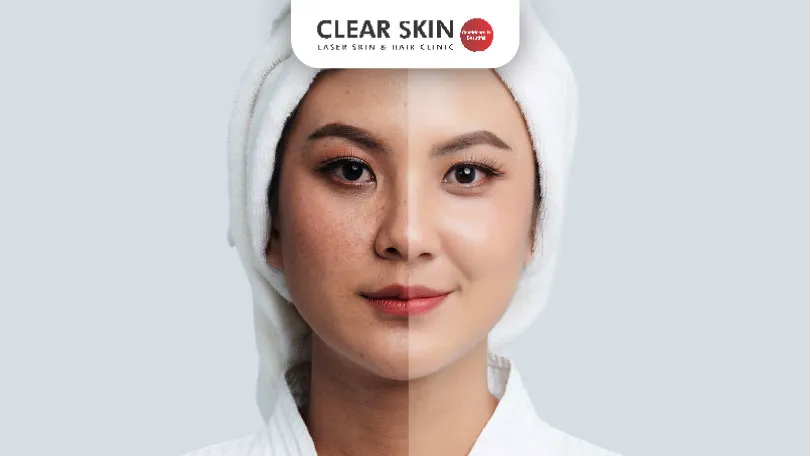Everything You Need To Know About Melasma
Reviewed By: Dr. Dhananjay Chavan
Updated on: 23th February, 2024

Table Of Content
-
Melasma: Everything You Need To Know
-
Why does it occur?
-
Types and Patterns of Melasma
-
What are the symptoms of melasma?
-
How to treat melasma?
- Conclusion
Melasma: Everything You Need To Know
You must have come across women, especially pregnant women, with brown colored patches on their cheeks. They seem like freckle-like spots forming large, flat patches. This is nothing but melasma. It is so common during pregnancy, that’s it’s often called “the mask of pregnancy”.
Melasma is a common chronic skin condition, resulting in symmetrical, blotchy, brownish facial pigmentation. Usually appears on a face – cheeks, forehead, bridge of a nose, above the upper lip, chin; and on other parts of the body exposed to the sun, like neck and forearms. Rarely seen in males, it’s mostly seen in women aged 20-50 years.
Why does it Occur?
Basically, the pigmentation is due to overproduction of melanin (ie the color pigment), by the pigment cells of the skin called melanocytes. That is why people who tan easily or have naturally brown skin are more prone to melasma because they have more active melanocytes compared to people with lighter skin.
Melasma also has a genetic predisposition. In addition to that, these are its triggering factors:
- Sun exposure: Uncontrolled exposure to sun, in view of poor compliance with sunscreen, is the leading cause and trigger. UV light from the sun stimulates the melanocytes, increasing pigmentation by way of increased melanin production. That explains why melasma is often worse in summers, and why it tends to keep recurring.
- Hormonal changes: Internal hormonal changes, as seen in pregnancy, stress, thyroid disorders as well as exogenous hormone treatments in the form of oral contraceptives, intrauterine devices, hormone replacement therapy, etc are all implicated in the triggering of melasma.
- Medications: Certain medications like anti-seizure drugs, anti malignant drugs could also be causative.
- Skin care products: Scented soaps, toiletries, cosmetic and skin care products that irritate skin may increase melanin production and accelerate melasma symptoms.
Types and Patterns of Melasma
Now the overproduced melanin can either be taken up by keratinocytes present in the epidermis, ie the outer layer of skin; or it can be deposited in the inner layer of skin called the dermis.
- The former leads to epidermal melanosis, with a well-defined border and responding well to treatment; while the latter leads to dermal melanosis, that behaves in the exact opposite manner.
- The mixed type includes both and is most commonly observed.
- Lastly, the fourth type is an unnamed type found in dark-complexioned individuals possessing excess melanocytes.
Melasma is found on both sides of the face, indistinct patterns like:
- Centrofacial pattern: Most prevalent form. Involves forehead, cheek, nose, and upper lips.
- Malar pattern: Cheeks and nose.
- Mandibular pattern: Jawline.
What are the Symptoms of Melasma?
Melasma does not have any symptoms. So while these dark patches are neither itchy, raised or painful, they are unbecoming to the eye and may cause embarrassment and distress to the individual, leading to self-image issues. Prevention and treatment for eclipsing the patches can primarily be focused on protection to the skin from the sun.
In presence of itching, pain, or tenderness, immediately get it consulted because hyperpigmentation could also be a symptom of potentially more serious conditions.
How to Treat Melasma?
Being harmless, melasma doesn’t need treatment other than for cosmetic purposes. And the treatment would need to be regular to avoid recurrence on continued exposure to the sun. It is advised that you conduct the treatment under the guidance of a qualified dermatologist to avail of optimum results.
Here’s what you can do:
- Sun protection: Sun being the main culprit, daily protection from the sun tops the list for treating and preventing melasma. A sunscreen with SPF of at least 50 is to be applied daily, every few hours, even if it has to be applied over any of the following topical creams. Its habitual use also enhances the effectiveness of other treatments.
- Hydroquinone: Available in cream, lotion, gel, or liquid forms, hydroquinone is a lightening or depigmenting topical agent, that works by inhibiting tyrosinase, an enzyme involved in melanin production, thereby decreasing the melanin levels in the skin. It can be bought over the counter in low doses (2%), and by prescription in higher doses (4%). At still higher doses, it ironically causes darkening of the skin, known as hydroquinone-induced ochronosis, and is to be discontinued. When used under supervision, hydroquinone is considered to be the ‘gold standard’ of melasma treatment.
- Retinoids and Corticosteroids: These can be bought only by prescription, and are usually given secondary to hydroquinone. Retinoids help by increasing the skin cell turnover, while corticosteroids work by lightening the affected areas.
When patients don’t respond to hydroquinone alone, “triple cream”, containing hydroquinone, tretinoin, and a corticosteroid is a good option.
- Other topicals: Azelaic acid (20%), kojic acid, cysteamine hydrochloride (5%) may also be effective, but to be used only after a skin patch test to rule out allergy.
- Chemical peels: If the topicals don’t work, chemical peels can be tried out, but only under supervision. As per your skin type, the dermatologist will choose the type and strength of the chemical peel best suited to you. 30-70% glycolic acid peels, and a mix of 10% glycolic acid and 2% hydroquinone peels are preferred for use in melasma.
- Microdermabrasion: Mechanical exfoliation by microdermabrasion can be performed in case of lack of results from topical treatments. Here, vacuum suction and an abrasive material are used to exfoliate the top layers of skin. Multiple sessions are needed, in combination with sunscreen and other creams for ensuring the best results.
- Laser therapy: Lasers may be used in melasma, but produce only temporary results. Repeated sessions are needed to witness sustainable improvement. Though, in some cases, they’ve been known to worsen the pigmentation, too.
How long does it take for melasma to fade?
Does Kojic acid work for Melasma?
Do You Know?
Roughly 250 Patients Are Treated
Everyday By These Dermatologists
(You are one click away from flawless skin)
Meet Our Dermatologist!
Conclusion
Melasma may occasionally clear out spontaneously, without treatment, especially in pregnant women, once they’ve delivered the baby and the hormonal imbalance has been regularised. Also, pregnant and breastfeeding women need to follow the instructions set out by the dermatologist, since the use of many of the melasma treatment creams may prove harmful to the foetus and the newborn.
In case of further doubts, consultation, or discussion of treatment options, you’re welcome to contact us at Clear skin Clinic.
Further Reading
How to Avoid Acne in Monsoons?
Avoid acne in monsoons with a gentle skincare routine, diet tips, and hydration. Get expert advice to manage breakouts and keep your skin clear and healthy.
Does Makeup Cause Acne-Prone Skin?
Worried about breakouts from using makeup? Does makeup cause acne for you? Learn the safe ways to apply makeup for acne-prone skin.
Morning Skin Care Routine for Glowing Skin
Clear Skin Clinic, led by top dermatologists, shares the ideal morning skincare routine to help you achieve a radiant complexion naturally and effectively.
Monsoon Skin Care Tips for Radiant, Healthy Skin
Clear Skin Clinic, led by top dermatologists, shares the ideal morning skincare routine to help you achieve a radiant complexion naturally and effectively.
Have thoughts? Please let us know
We are committed not only to treating you, but also educating you.





